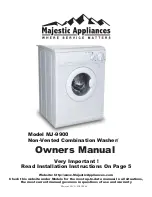
25
WARNING
Work on the electrical equipment
must only be carried out by
specialised personnel, with the
power supply disconnected.
K.6
Waste storage
At the end of the product's life-cycle, make sure it is not
dispersed in the environment.
Depending on the model, the doors must be removed before
scrapping the appliance.
SPECIAL waste materials can be stored temporarily while
awaiting treatment for disposal and/or permanent storage. In
any case, the current environmental protection laws in the
user's country must be observed.
K.7
Procedure regarding appliance
dismantling macro operations
Before disposing of the machine, make sure to carefully check
its physical condition, and in particular any parts of the
structure that can give or break during scrapping.
The machine's parts must be disposed of in a differentiated
way, according to their different characteristics (e. g. metals,
oils, greases, plastic, rubber, etc.).
Different regulations are in force in the various countries,
therefore comply with the provisions of the laws and
competent bodies in the country where scrapping takes place.
In general, the appliance must be taken to a specialised
collection/ scrapping centre.
The symbol on the product indicates that this
product should not be treated as domestic
waste, but must be correctly disposed of in
order to prevent any negative consequences
for the environment and human health. For
further information on the recycling of this
product, contact the local dealer or agent, the
Customer Care service or the local body
responsible for waste disposal.
WARNING
Make the appliance unusable by
removing the power cable and
any compartment closing devi-
ces, to prevent the possibility of
someone
becoming
trapped
inside.
NOTE!
When scrapping the machine, the “CE“ marking,
this manual and other documents concerning the
appliance must be destroyed.
L
TROUBLESHOOTING
L.1
Common faults
DISHWASHER DOES NOT WASH
WELL
1. Check if the suction filter is dirty and clean it thoroughly.
2. Check if the wash jets are clogged by solid food remains.
3. Check that the initial amount of detergent or subsequent additions are correct.
4. The selected wash cycle is too short. Repeat the cycle.
5. Check the tank temperature.
6. Check that the dishes are stacked correctly in the racks.
GLASSES AND DISHES ARE NOT
DRIED PROPERLY
1. Check the instructions for the amount of rinse-aid (see H.2
paragraph).
2. Check that there is rinse-aid in the container and if necessary top up.
3. Check the set amount of rinse-aid (see H.2
paragraph).
4. Check the water temperature of the boiler.
CONDENSATION ON GLASSES
1. Check that there is rinse-aid in the container and if necessary top up.
2. Check the set amount of rinse-aid (see H.2
paragraph).
3. Remove the rack of glasses immediately the cycle has ended.
STAINS ON THE GLASSES
1. Only use “non-foaming” products for professional dishwashers.
EXCESSIVE FOAM IN THE TANK
1. Check that the wash water temperature is not less than 50
℃
.
2. Check if the amount of product dispensed by the detergent dispenser is excessive
(see H.2
paragraph).
3. Ensure that the tank has not been cleaned with unsuitable cleaners. Drain the
tank and rinse thoroughly before new wash cycles.
4. If a foaming detergent has been used, drain and refill the tank with water until the
foam disappears.
SMEARS OR SPOTS ON THE
GLASSES
1. Reduce the amount of rinse-aid (see H.2
paragraph)
THE WASH OR RINSE ARMS TURN
SLOWLY
1. Remove and thoroughly clean the arms.
2. Clean the wash pump suction filter.




































